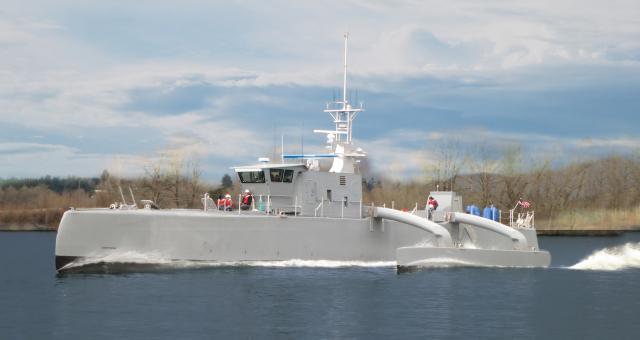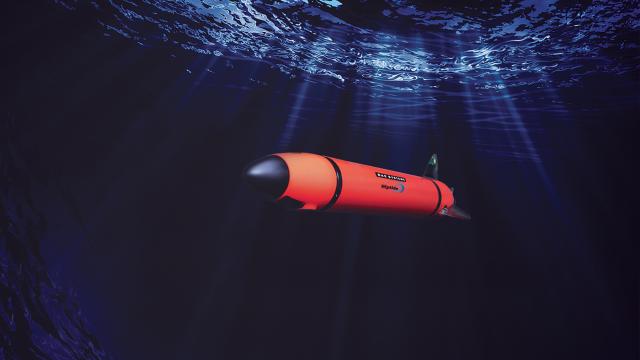Mine hunting, finding, and sweeping are not marginal operations. The assets performing these missions must undertake careful thought and preparation, as “countering mines cannot be made easy, cheap, or convenient.”1 With the current mine countermeasures (MCM) force limited in personnel, material, and money, the Navy needs a new concept of operations that relies more on automated unmanned systems.2
Despite extensive research and development, however, current unmanned MCM vehicle concepts still require the nearby presence of a manned vessel. Pairing extra-large unmanned underwater vehicles (XLUUVs) and unmanned surface vessels (USVs) with microsized UUVs would permit long-distance transits and increased on-station time without putting manned crews at risk. It also would allow the MCM force to hunt while it sweeps.
The Wonsan Legacy
The Navy has a habit of marginalizing mine warfare in peacetime. During World War II, large MCM forces ensured troop landings at Okinawa and Normandy.3 Unfortunately, less than a decade later, the U.S. mine-warfare fleet in the Pacific had shrunk to a mere ten vessels.4 This proved nearly catastrophic during the amphibious landings on the Korean Peninsula, as the North Koreans, with Soviet assistance, had laid 3,000 mines in and around Wonsan harbor.5 The advance force commander at Wonsan, Rear Admiral Allan E. Smith, said, “We have lost control of the seas to a nation without a navy, using pre–World War I weapons, laid by vessels that were utilized at the time of Christ.”6 U.S. forces paid a dear price for the Navy’s failure to maintain an effective mine force.7 It is incumbent on leaders and tacticians today to ensure the Navy continually innovates and evolves to avoid the same fate.
U.S. adversaries—especially those who are outmatched in terms of gun and missile firepower—will continue to deploy mines. Vice Admiral C. Turner Joy, Commander Naval Forces Far East during the Korean War, commented on the importance of future mine-warfare efforts after the delayed landings at Wonsan:
The main lesson of the Wonsan operation is that no subsidiary branch of the naval service, such as mine warfare, should ever be neglected or relegated to a minor role in the future. Wonsan also taught us that we could be denied freedom of movement to an enemy objective through the intelligent use of mines by an alert foe.8
The state of today’s mine-warfare force parallels the one called into action at Wonsan, but that does not mean it has to suffer the same outcome.9 Even though a large-scale amphibious operation such as the landings at Wonsan may no longer be tactically feasible, the adversary can still mine a tactically significant port or waterway in the midst of a war.10
Putting a surface vessel near a minefield puts the ship in danger of not only mines, but also antisurface weapon systems afloat and ashore. For example, although the littoral combat ship (LCS) is equipped to operate a Common Unmanned Surface Vehicle, it has a limited air-defense capability. To defend the LCS against antiship cruise missiles during MCM operations, the multimission Arleigh Burke–class DDG could provide air defense, but this would remove a highly capable asset from other missions. Rather than leaving the primary mine hunter at risk or allocating additional resources for its defense, autonomous unmanned vehicles can be employed to clear minefields with less risk to manned ships.
Going Fully Autonomous
Autonomous vehicles are true force multipliers that keep sailors and assets out of harm’s way. XLUUVs can sweep mines while the microsized UUVs hunt for others. Current manned surface MCM tactics do not permit simultaneous mine sweeping and hunting, as the maneuvering and speed requirements for each are incompatible. This limitation makes mine warfare so time-consuming it can cripple an operation, just as it did at Wonsan. The technology to do both tasks simultaneously is close to fruition, and the Navy must be prepared to apply it when it is fully developed.
Making MCM operations a primarily unmanned systems mission conducted by explosive ordnance disposal units or MCM units ashore would create a capable force able to clear and sweep mines in a timely manner, with little risk to human life. An XLUUV with several microsized UUVs on board has both the endurance and the stealth required to safely conduct its mission without assistance from other warships. This is close to the Raytheon concept of operations that uses the Common Unmanned Surface Vessel as a mothership and sweeping platform, with the Barracuda expendable mine neutralizer as the primary mine-hunting asset.11 An autonomous unmanned MCM fleet would allow the mine-warfare package–equipped LCSs to operate in a “clean up” or “pouncer” role, focusing on smaller areas with less risk to the force. The Navy also would need fewer mine warfare–capable LCSs, generating greater force-structure flexibility.
Clearing a large minefield is difficult to do without alerting the enemy, but using XLUUVs makes that possible. The Navy has contracted for four Boeing Orca XLUUVs, which have an impressive endurance of 6,500 nautical miles (nm). The Orca design is based on Boeing’s Echo Voyager, which is 51-feet-long and, according to the Navy outline of the systems capability development, will be capable of conducting missions in several warfare areas, including MCM.12 Although the Orca will not be able to conduct large-scale sweeping operations that a surface vessel can, it will still be able to locate mine-like objects with its onboard sonar and dispatch microsized UUVs for classification and neutralization. Having an undersea option to conduct MCM operations allows operational commanders to prepare the battlespace while maintaining a covert posture—not possible with currently fielded mine-sweeping and -hunting systems.
Autonomous unmanned systems also are far more cost-efficient than manned platforms. The four Boeing Orcas cost $42.3 million total, and the antisubmarine warfare continuous trail unmanned vehicle (ACTUV) costs $25 million per vessel.13 This is in stark contrast to the $588 million it costs to build a Freedom-class LCS or the $1.8 billion to build an Arleigh Burke.14 Eliminating ship maintenance and operating costs frees funding for other mine-warfare projects, such as integrating multiple unmanned, autonomous systems.
Another Korea Example
The ACTUV can access mined waters from well over the horizon, with a range of 10,000 nm when operating at 12 knots.15 Consider a second Korean war—this endurance would allow the ACTUV to leave Sasebo, Japan, and conduct a mine warfare mission anywhere around the Korean Peninsula and return without having to stop for fuel. An ACTUV would still be vulnerable to attacks from the air, just as an LCS is, but losing an ACTUV is far less critical than losing an expensive LCS and its crew.16 Furthermore, the ACTUV’s fiberglass hull reduces its vulnerability to magnetic-influence mines. The Navy already has conducted the first ACTUV tests with a mine-warfare package, and a second ACTUV is under contract.
ACTUVs are large enough to carry a variety of mine-warfare payloads, such as the Towed Airborne Lift of Naval Systems, which is a towed tactical paraglider that can extend the range of electromagnetic sensors. ACTUVs can communicate with smaller UUVs that do not have the height of eye to communicate at extended ranges, enabling them, as with the XLUUV, to sweep and hunt mines simultaneously over a large area. Microsized UUVs, such as the Riptide and Barracuda, can take advantage of shrinking payloads and state-of-the-art battery technology to better find, classify, and neutralize mines at the same cost of one-time-use sonobuoys.17 Riptide microsized UUVs can be powered by aluminum-seawater batteries, a new technology that produces impressive energy density without the safety concerns associated with other batteries and allows larger survey areas.18
The time it takes to sweep an area clear of mines is always pitted against the timeline of war. Sweeping and hunting an area simultaneously with minimal resources is a challenge, but as technology advances, the capability unmanned systems will bring to the fight makes it achievable. The fleet needs a new roadmap to counter mines in the most difficult environments. Hunt while you sweep is the future, and the path to get there involves extra-large and microsized unmanned vehicles.
1. Tamara Moser Melia, Damn the Torpedoes: A Short History of U.S. Naval Mine Countermeasures, 1777–1991, Naval Historical Center, 1991.
2. Yasmin Tadjdeh, “Navy Invests in New Mine Warfare Technology,” National Defense, 6 April 2020, www.nationaldefensemagazine.org/articles/2020/4/6/navy-invests-in-new-mine-warfare-technology.
3. Malcom W. Cagle and Frank A. Manson, The Sea War in Korea (Annapolis, MD: Naval Institute Press, 1957).
4. Cagle and Manson, The Sea War in Korea.
5. George W. Bear, One Hundred Years of Sea Power: The U.S. Navy, 1980–1990 (Palo Alto, CA: Stanford University Press, 1994).
6. Melia, Damn the Torpedoes, 76.
7. Cagle and Manson, The Sea War in Korea.
8. Cagle and Manson.
9. Robert Faturechi, Megan Rose, and T. Christian Miller, “Iran Has Hundreds of Naval Mines. U.S. Navy Minesweepers Find Old Dishwashers and Car Parts,” ProPublica, 5 August 2019, www.propublica.org/article/iran-has-hundreds-of-naval-mines-us-navy-minesweepers-find-old-dishwashers-car-parts.
10. Zachary Keck, “Why D-Day Would Fail Today,” The Diplomat, 8 June 2014, thediplomat.com/2014/06/why-d-day-would-fail-today/.
11. Tadjdeh, “New Mine Warfare Technology.”
12. Ben Werner, “Navy Awards Boeing $43 Million to Build Four Orca XLUUVs,” USNI News, 17 April 2019.
13. Werner, “Navy Awards Boeing $43 Million to Build Four Orca XLUUVs”;
Jon Rosamond, “DSEI: Navy Poised to Order Second Vessel for ACTUV Sea Hunter Test Program,” USNI News, 15 September 2017, news.usni.org/2017/09/15/dsei-navy-poised-order-second-vessel-actuv-sea-hunter-test-program.
14. Sam LaGrone, “NAVSEA: New Navy Frigate Will Cost $950M Per Hull,” USNI News, 10 January 2018, news.usni.org/2018/01/09/navsea-new-navy-frigate-will-cost-950m-per-hull-double-lcs-cost.
15. Julian Turner, “Sea Hunter: Inside the U.S. Navy’s Autonomous Submarine Tracking Vessel,” Naval Technology, 30 January 2020, www.naval-technology.com/features/sea-hunter-inside-us-navys-autonomous-submarine-tracking-vessel/.
16. LaGrone, “NAVSEA: New Navy Frigate.”
17. Jeffrey M. Smith, “The Next Big Thing in Undersea Warfare May Be Micro,” Undersea Warfare (2017), 17–19.
18. Smith, “The Next Big Thing in Undersea Warfare,” 17–19.





